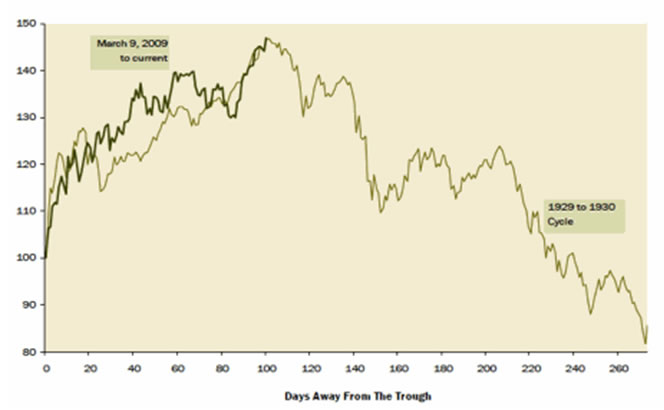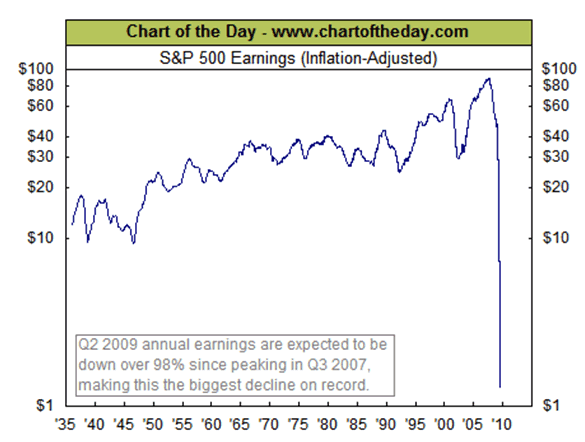N Rothschild
Legendary member
- Messages
- 5,296
- Likes
- 603
nothing new!
Stocks Bear Market NOT Over, Stocks WILL Crash this Fall!
Aug 05, 2009 - 01:47 AM
By: Graham_Summers
Yesterday we detailed the different between this current economic contraction, and your usual run of the mill plain vanilla recessions. We also went over the MASSIVE consumer credit contraction that needs to occur before American households have finished de-leveraging.
Today, we’re detailing why stocks will Crash this coming fall. As you know the media is rife with folks calling the end of the recession and the beginning of a new bull market. It’s clear to me that this is a load of nonsense. Today I’ll show you why.
Because a lot of the alleged “analysis” that is backing up the bulls’ claims of a new bull market comes from technical analysis and charts, I’m presenting the below chart from David Rosenberg of Gluskin Shef. It charts today’s bear market over that of 1929-1932.

As you can see, today’s bear market is mirroring that of the ‘30s almost to perfection. Indeed, the correlation between the two charts is an incredible 0.8, meaning it’s 4/5ths perfect. In finance, you’re lucky if you get a correlation above 0.6. (gold and the dollar are only 0.28 inversely correlated). A 0.8 correlation is virtually unheard of. But that’s exactly how closely today’s market is mirroring that of the ‘30s.
I can’t take full credit for this insight. Ron Coby, an investment manager at Coby Lamson in Oregon first started pointing out the similarities between this market and that of 1929 back in February ’09. No one wanted to listen to him then.
They’re listening now.
Coby notes that from October 29, 1929 until November 13, 1929, the stock market collapsed 48% (the 2008 Crash was 52%). Then from November 1929 to April 1930 the market staged a 155-day rally of 50%. Today’s rally (starting in March ’09) has lasted 150 days and the market is up an average of 50% (average of Nasdaq, DJIA, and S&P 500).
Unfortunately for the bulls today, the 1929 market then rolled over and collapsed another 70%. “Bottom callers” INCLUDING legends like Jesse Livermore, Benjamin Graham and others bought ALL THE WAY DOWN, losing entire fortunes.
Ok, so the charts for today and 1929 are identical, what about the earnings? After all, profits are ultimately what drive the stock market: you buy based on expected future earnings of the companies.

Earnings today are even lower than they were in the ‘30s during the Great Depression. They’ve fallen 98% from their peak in 2007. Adjusted for inflation, stocks have NEVER been this unprofitable in the last 80 years.
The US was already in a recession in 2008. And 2Q09 profits are actually down 31% even from THAT. Indeed, based on ACTUAL posted earnings, the S&P 500 is trading at a P/E of 700 today. Even if you go by operating earnings the multiple is still 24: hardly cheap.
Looking over this, I can’t see where any claims of a “bull market” are coming from. The people who are saying today is a new bull market probably went long Tech Stocks in 2001, Housing in 2006, and Financials in 2008.
In light of the rampant bullishness, the parabolic rally in the S&P 500, the horrific earnings, and the similarity between today’s rally and that of 1929, I believe the likelihood of another Crash (like 2008) is quite high. In fact, I would not be surprised to see stocks collapse within the next eight weeks.
I’ve put together a FREE Special Report detailing THREE investments that will explode when stocks start to collapse. I call it Financial Crisis “Round Two” Survival Kit. These investments will not only protect your portfolio from the coming carnage, they’ll also show you enormous profits: they returned 12%, 42%, and 153% last time stocks collapsed in 2008.
Swing by Subscribe Now to Gains, Pains, & Capital to pick up your FREE copy!!
Good Investing!
Graham Summers
Gains, Pains, & Capital
Graham Summers: Graham is Senior Market Strategist at OmniSans Research. He is co-editor of Gain, Pains, and Capital, OmniSans Research’s FREE daily e-letter covering the equity, commodity, currency, and real estate markets.
Graham also writes Private Wealth Advisory, a monthly investment advisory focusing on the most lucrative investment opportunities the financial markets have to offer. Graham understands the big picture from both a macro-economic and capital in/outflow perspective. He translates his understanding into finding trends and undervalued investment opportunities months before the markets catch on: the Private Wealth Advisory portfolio has outperformed the S&P 500 three of the last five years, including a 7% return in 2008 vs. a 37% loss for the S&P 500.
Previously, Graham worked as a Senior Financial Analyst covering global markets for several investment firms in the Mid-Atlantic region. He’s lived and performed research in Europe, Asia, the Middle East, and the United States.
© 2009 Copyright Graham Summers - All Rights Reserved
Disclaimer: The above is a matter of opinion provided for general information purposes only and is not intended as investment advice. Information and analysis above are derived from sources and utilising methods believed to be reliable, but we cannot accept responsibility for any losses you may incur as a result of this analysis. Individuals should consult with their personal financial advisors.
Cheap oil is a thing of the past. This is one of the reasons that we are not going to see deflation for more than a short period. Supply can no longer exceed demand when it attempts to rise. Consequences do not bear thinking about.
The peak oil situation doesn't matter yet. We saw a drop in demand in the last year so the supply/demand situation is not critical. Oil markets are pricing in future demand, due to a rise in stock markets, rather than a return to demand.
The inflation v deflation argument is to do with timing- the markets are IN a deflationary situation now so the question is how long. Inflation is an afterthought for maybe a year or two down the line.
Excess capacity is being removed from the system and its too early to know when this will end.
doubt we will see 100$ oil again for a long time..As I have posted before, I believe that the deflationary cycle that we are seeing in the US is a symptom of what is going to happen. Year on year budget and trade deficits. We saw a spike in oil prices which suggests that when push comes to shove the oil producing nations are struggling to meet demand. Most of the easy to remove oil has been used up, thats why Albert tar sands are being mined and the Brazilians are drilling in 7000 meter ocean depths. The developing Asian economies are using more oil than ever before and demand will carry on increasing in these countries. Removing capacity from the system is another cause of inflation. Taking away supply while flooding an economy with cheap money will add to inflationary pressure down the line.
doubt we will see 100$ oil again for a long time..
Funny how both Pimco and Warren Buffett came out the same day with concerns over inflation. Warren Buffett's op-ed is an interesting read on the possibilities of inflation. Here's Buffett's piece http://www.nytimes.com/2009/08/19/opinion/19buffett.html?_r=2&ref=opinion
that was bretton woods, not the actual gold standard
if anything the iraw qar insured that the $ would continue on as the worlds reserve currency, through oil
